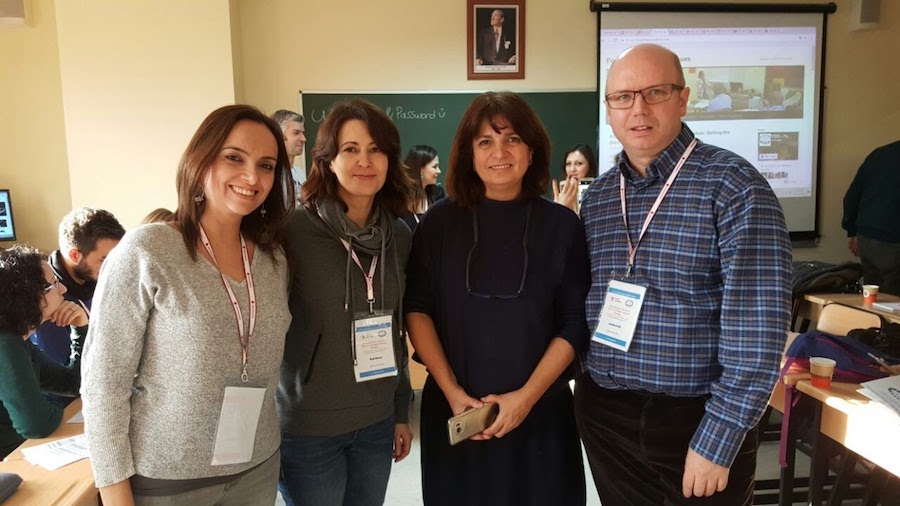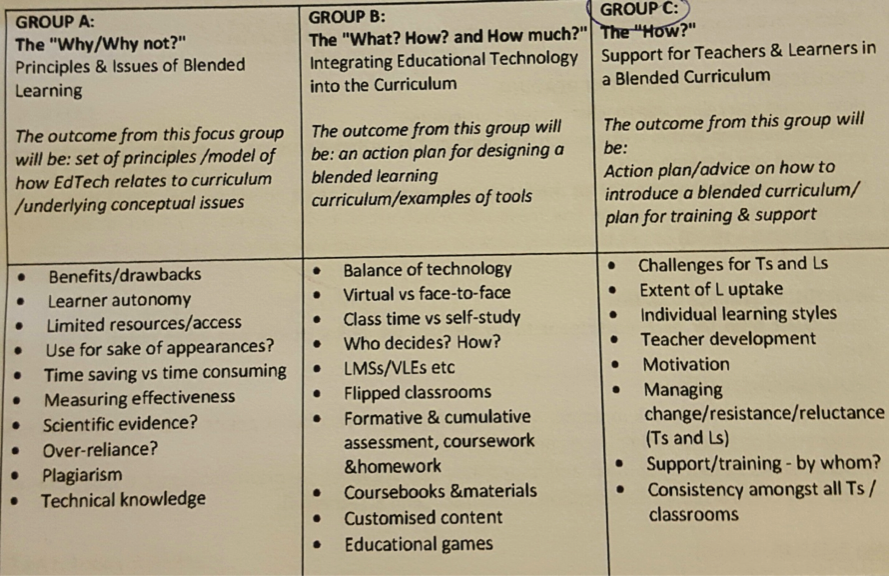
FOCI-XIV: Technology & the Curriculum: Getting the Blend Right
A Review by Berna Akpınar Arslan and Mutlu Bosson
The 14th FOCI event took place on December 15th and 16th, 2016 and was hosted by Doğuş University in Istanbul. Educational technology, a topic of high interest to many of us involved in language teaching and learning, was at the centre of this event. As stated on the FOCI website, the main purpose of these two days was ‘to clarify the practical ways of systematically integrating technological tools into the delivery of the curriculum in such a way that will allow technology to be exploited in a pedagogically effective way in our classes’.
The first step to looking into the place of technology in the curriculum was the pre-event reading task. This included three articles (sources given at the end of this review) that focused on challenges and possible solutions to blended learning (Bugon, 2016); the parallels between constructivism and affordances of certain technological tools and platforms (Kaya, 2015) and a provisional list of principles to consider when evaluating a new learning tool (Thornbury, 2016).
One takeaway from the pre-event readings as well as the event was the need to think critically when integrating technologies into the curriculum. The importance of a principled and mindful approach to utilising technology in language education also came up during the Q & A session on Thursday morning. Haldun Kaya from Izmir University of Economics, whose article on blended technology and constructivism was included in the pre-event reading task, joined us on Skype, a fitting way to open the event considering the theme. He took questions from the participants on his article and the use of educational technologies. He drew an interesting analogy between educational technologies and a double-edged sword. When deciding whether to integrate a certain technological tool into our teaching and curriculum, teachers and curriculum designers need to consider both the affordances and hindrances that this tool brings.
The second presentation of the day was titled ‘Myths and Ed Tech’ and delivered by Emrah Akkurt from Istanbul Şehir University. During his presentation, he also
highlighted the significance of a thoughtful approach to blended learning. He referred to two interesting concepts: ‘the hype cycle’ and ‘the novelty effect’. In the context of language education, there is an initial period of hype surrounding a new technology because it is novel. During this period these technologies may be integrated into the curriculum, not necessarily because of their true educational value, but often because they are new and there is an increased interest in them. However, it would be wise to wait for the novelty effect and the hype cycle to take their courses and not be dazzled by all the shiny bells and whistles some of these tools come with. Ultimately, we should carefully consider how these technologies can improve learning and teaching in our specific contexts.
After this whole group gathering, we went on to work in three focus groups in order to prepare our group presentations to be given on the second day of the event. We were all given a scenario, in which we were asked to develop and implement a blended curriculum. The first group worked on the ‘why /why not’, the second group on the ‘what and how much’ and the third group on the ‘how’ of a blended curriculum. The focus group discussions proved to be a very productive portion of the event. It gave the participants the chance to further share ideas and examples of good blended practices from their institutions. These discussions were also a great way to draw attention to the many issues, big and small, curriculum designers need to tackle when blending the curriculum such as learner needs, interests, motivation and learning styles, the balance of technology, assessment and homework issues, teacher and learner training, challenges and possible solutions.
On the second day of the event, the representatives of three institutions listed below presented a curricular innovation involving educational technology in their contexts. It was very useful to hear different perspectives with specific reference to the experiences they had.
University of Turkish Aeronautical Association
Çisem Altuğ from University of Turkish Aeronautical Association delivered a presentation on how an e-portfolio was designed and implemented for writing tasks and feedback process in their institution. The idea of using an online platform, Google Drive, to keep a learner portfolio seems to be efficient in many ways, particularly eliminating student related issues like losing the copy of their work and not meeting the deadline. They use colour coding for error correction, track changes function of MSWord when giving feedback on writing and prefer Screencast-O-Matic, a free screen recording tool for instant screen capture and sharing purposes, to provide oral feedback on the written products of learners.
TOBB University of Economics and Technology
Berrin Cefa Sarı from TOBB University of Technology described how they integrate technology into their curriculum by giving specific examples , namely using Google Docs to store and access portfolio activities and tasks, keeping track of student progress through online components of the course books, like MyEnglishLab and MyELT, and creating competition opportunities while learning and revising vocabulary by means of student response systems (SRS) such as Quizlet, Quizziz, Padlet, Kahoot, Oyunus, Remind, Memrise. The feedback from students and teachers is said to have been positive particularly about Google Drive with regard to practicality of task completion and submission and SRSs for making vocabulary learning fun and meaningful.
Bahçeşehir University
Ayşegül Pamukçu from Bahçeşehir University described how they have managed to create an effective blended learning component in their program. She put emphasis on the fact that blended learning must be designed using a model and mentioned the model they adopted, which is the Substitution, Augmentation, Modification, Redefinition Model (SAMR) by Dr. Ruben Puentedura (2013). Moreover, they took Bloom’s taxonomy into consideration while embedding a variety of technological tools into one main platform using Educaplay. Both asynchronous and synchronous applications of the technology were explained; the former involving functions like document sharing, assignment submission, and forums and the latter including in class applications like Quizlet, Educaplay, TED Ed, TED talks, Socrative , Kahoot, Adobe Connect, etc.
Focus Group Presentations
The last part of the event was allocated for the presentations by three focus group representatives that discussed the points below:

Having focused on the issues with regard to the scenario assigned thoroughly, each group presented the highlights of their discussion by outlining the ideas and suggestions they agreed on to the whole audience. The main idea of all the presentations was the fact that blended learning is a valuable asset and the decision making process in its design is highly important as the criteria and rationale for adopting blended learning must make sense to teachers and learners and should take into consideration the needs of the context.
The main points from focus group presentations can be outlined as below:
•The aspects of educational technology experience: Content delivery, digital literacy, communication with learners, self study, homework, feedback, assessment, logistics.
•Models to use while designing blended learning: SAMR, TECH, and TPACK
•The principles while integrating educational technology into curriculum: Meeting a need, enhancing learning and teaching, being accessible, practical and relevant.
•The benefits of blended learning: Educational technology proves to be timesaving, easily adaptable, user friendly, a way to practice outside class, engaging and a good way to teach various skills, record keeping.
•The issues to consider carefully when selection a specific approach or tool: Plagiarism, resistance from teacher and students, availability of training opportunities, overreliance, unreliability, and financial cost.
All in all, it is highly crucial to note that despite the drawbacks of educational technology, the benefits of it make it an essential part of curriculum in most institutions. If institutions have the necessary technological infrastructure and training opportunities for both learners and teachers as well as a critical approach to educational technologies, blended learning will enhance learning and teaching experiences.
Articles referred to:
Bugon, G. (2016). "Blended Learning: Language Learner Perspectives and Experiences". The Journal of Teaching English for Specific and Academic Purposes (4) 1 pp.137-150.
Kaya, H. (2015). "Blending Technology with Constructivism: Implications for an ELT Classroom". Teaching English with Technology (15) 1 pp. 3-13.
Thornbury, S. (2016). In Michael McCarthy, The Cambridge Guide to Blended Learning for Language Teaching, Cambridge University Press, pp. 25-35.
